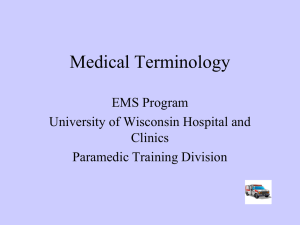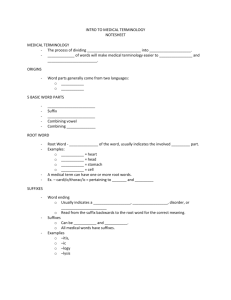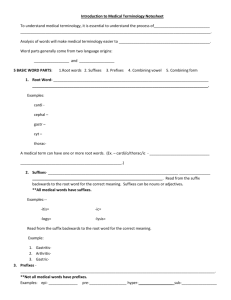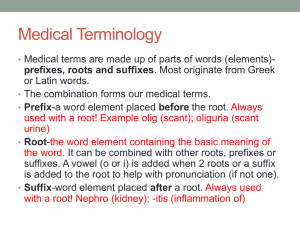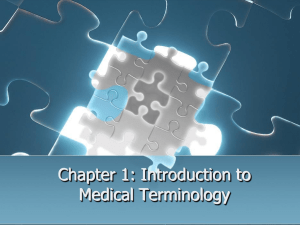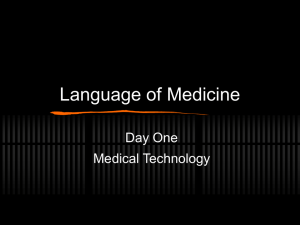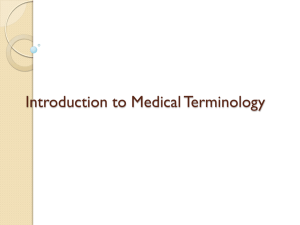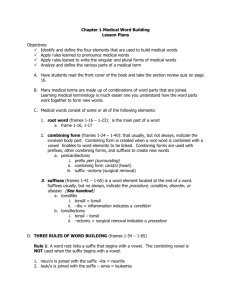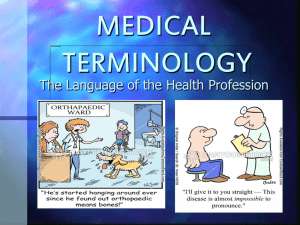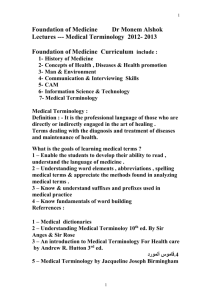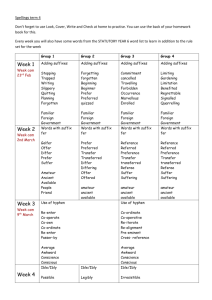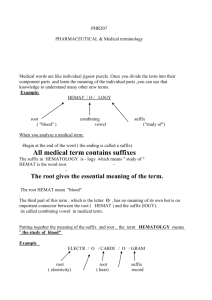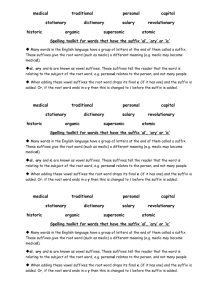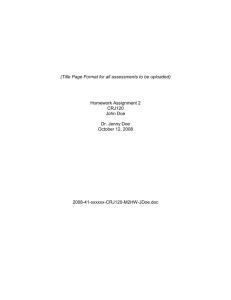Medical Termiology
advertisement
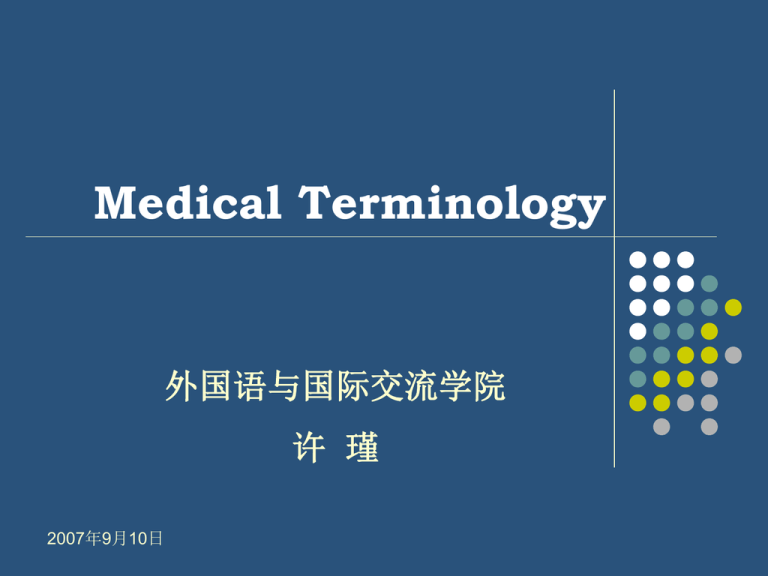
Medical Terminology 外国语与国际交流学院 许 瑾 2007年9月10日 The study of medical terminology is the study of the parts that make up medical words and the building of both a general vocabulary and a vocabulary for each of the body systems. Few linguistic concepts need be understood before you can analyze the terms themselves. Most medical words are made from a combination of the following elements: 2007年9月10日 Basic Elements of the Medical Words: 2007年9月10日 Base form Combining Vowel Prefix Suffix BASE is the part of a word that contains the most fundamental meaning of the word. sometimes called a root or a stem; capable of combining with another base or suffix to form a medial word that has meaning 2007年9月10日 For example: gastroptosis -gastr- stomach Electrocardiogram -cardi- heart hepatitis -hepat- liver dental -dent- tooth 2007年9月10日 When two bases are combined or a suffix is added to a base, if no vowel occurs at the junction of the two forms, a vowel called the COMBINING VOWEL is added. O is the most commonly occurring combining vowel; I is the second most common combining vowel; We call a base with a combining vowel a combining form. 2007年9月10日 For example: ur/o/log/y o uro- nephr/o/lith o nephro- cardi/o/vascul/ar o cardio- mill/i/meter i milli- pelv/i/meter i pelvi- 2007年9月10日 PREFIXES are placed before a word to alter the basic meaning of the word. SUFFIXES appear at the end of the word and, in a sense, function like prefixes. Suffixes, however, not only alter the meaning of a word, but they also determine the various word functions, such as part of speech or whether the word is singular or plural. 2007年9月10日 Exercise: anemia microbe germicide microscope cardiovascular 2007年9月10日 A suffix is added to the end of a word base to change the meaning of the base or to make the base a noun, verb, adjective, and so forth. In medical language there are two types of suffixes: simple and compound. 2007年9月10日 Simple suffixes are those suffixes that have nothing added to them. -itis inflammation hepatitis nephritis -y a condition atrophy dystrophy -al adj. suffix sublingual bronchial 2007年9月10日 A review of some simple suffixes -ia condition anemia -y condition, process splenomegaly -e instrument arthrotome -itis inflammation hepatitis -ist professional dermatologist -or doer incisor(切牙) -osis diseased condition sclerosis -oma tumor sarcoma 2007年9月10日 Compound suffixes are usually formed by joining a base and a simple suffix. For instance, we can join the base LOG and the suffix Y to make the compound suffix LOGY, which means the act or process of studying. 2007年9月10日 A review of some compound suffixes -algia pain -emia blood condition leukemia -uria urine condition hematuria -malacia softening osteomalacia -penia deficiency, lack leukocytopenia -rrhea flow, discharge diarrhea -cyte cell leukocyte -centesis surgical puncture amniocentesis 2007年9月10日 arthralgia -graphy process of recording -graph that which records -gram the record itself electrocardiogram -scopy examining visually cystoscopy -scope instrument for viewing ophthalmoscope -tomy incision craniotomy -ectomy excision appendectomy -stomy gastrostomy making an opening 2007年9月10日 Case Study for Exercise: D.S., a 28-year-old woman, was treated for injuries sustained in a train derailment accident. During the course of her treatment, she was seen by several specialists. For pain in her knee and hip joints, she was referred to an orthopedist(整形外科专家). For migraine headaches and blurry vision, she consulted a neurologist. For pain on urination and occasional bloody urine, she saw a urologist. Later, for a persistent dry cough and problems resulting from a fractured nose, she was referred to an otorhinolaryngologist. 2007年9月10日 During her initial course of treatment, she had a CT scan of her abdomen and brain and an MRI of her hip and knee. Both imaging studies required her to lie motionless on her back for 45 minutes. Several months after the accident, D.S. was still experiencing some discomfort, and she decided to investigate alternative therapies. She made an appointment with a naturist practitioner who specialized in homeopathy and herbal medicine. 2007年9月10日 Before her appointment, she browsed in the Nutra-Medica Shop, which carried nutritional supplements, vitamin and mineral products, homeopathic remedies, and herbal formulas. She planned to ask the therapist about some of the products that she saw there, which included remedies with the trade names Pneumogen, Arthogesia-Plus, Renovite, Nephrostat, and Hematone. 2007年9月10日 1. The –ist in the word neurologist is a A. prefix B. root C. suffix D. combining form 2. Endo- in endoscopic is a A. root B. suffix C. combining form D. prefix 3. D.S. needed plastic surgery on her nose to repair the postfracture deformity. This procedure is called a(n): A. septoscope B. rhinoplasty C. neurectomy D. rhinitis 2007年9月10日 4. Several of the radiological imaging studies required D.S. to lie on her back for 45 minutes. This position is referred to as: A. supine B. prone C. lithotomy D. lateral recumbent 5. The products Renovite and Nephrostat are named for their action on the: A. lung B. nerves C. liver D. kidney 6. The meaning of the roots in otorhinolaryngology is: -ot/o- for ___, -rhin- for ___, -laryng- for ___. 2007年9月10日 Forming Plurals Many medical words have special plural forms based on the ending of the word. Ending Pl. Ending Example Pl. Example a ae gingiva gingivae en ina foramen foramina ex, ix, yx ices appendix appendices 2007年9月10日 Ending Pl. Ending Example Pl. Example is ma es mata diagnosis sarcoma diagnoses sarcomata nx (anx, inx, ynx) on nges phalanx phalanges um us 2007年9月10日 a spermatozoon spermatozoa a i ovum embolus ova emboli Exercises: 1. Vertabra (bone of the spine) VER-te-bra 2. Ganglion (mass of the nerve tissue) GANG-lē-on 3. Omentum (abdominal membrane) ō-MEN-tum 4. Testis (male gonad) TES-tis 5. Lumen (central opening) LU-min 6. Matrix (background substance) MĀ-triks 7. Serum (liquid) SĒ-rum Vertebrae, ganglia, omenta, testes, lumina, matrices, sera 2007年9月10日 Pronunciation Notes: Pronunciations may vary from country to country, even in different regions of the same country. Think how easy it is to distinguish a southern accent and one from the midwest or northeastern United States. The general rule is to include the most common pronunciation. 2007年9月10日 The word gynecology is usually pronounced with a hard g in the United States, but in many areas a soft g is used, as in jin-e-KOL-ō-jē. Words pertaining to the cerebrum (largest part of the brain) may have an accent on different syllables. The adjective is usually pronounced with the accent on the second syllable (se-REbral), but in cerebrum (SER-e-brum) and cerebrospinal (ser-e-brō-SPĪ-nal), the accented syllable differs. 2007年9月10日 The name for the first part of the small intestine (duodenum) is often pronounced dū-ō-DĒ-num, although the pronunciation dū-O-de-num is also acceptable. When extreme, some alternate pronunciations can sound like a foreign language. The work we pronounce as SKELe-tal is pronounced in some other Englishspeaking countries as ske-LE-tal. 2007年9月10日 Silent letters and Unusual pronunciations A silent letter or unusual pronunciation can be a problem, especially if it appears at the start of a word. 2007年9月10日 Letters Pronunciation Example Definition of example ch k chemical Pertaining to chemistry dys dis eu u dystroph y euphoria gn n gnathic Poor nourishment of tissue Exaggerated feeling of well-being Pertaining to the jaw ph f pharmacy A drug dispensary 2007年9月10日 Letters Pronunciation Example Definition of example pn n pneumonia inflammation of lungs ps s pseudo- false pt t ptosis dropping rh r rheumatic pertaining to rheumatism x z xiphoid pertaining to cartilage attached to the sternum 2007年9月10日 Case Study While walking home from the train station, M.A., a 72-year-old woman with osteoporosis, tripped over a broken curb and fell. In the emergency department, she was assessed for severe pain, swelling, and bruising of her left thigh. A radiograph showed a displaced left femoral neck fracture. M.A. was prepared for surgery and given a preoperative injection of an analgesic to relieve her pain. 2007年9月10日 Intraoperatively, she was given spinal anesthesia and positioned on an operating room table, with her left hip elevated on a small pillow, intravenous antibiotics were given before the incision. Her left hip was repaired with a bipolar hemiarthroplasty. Postoperative care included maintaining the left hip in abduction, blood and fluid replacement, physical therapy, and vigilance for development of avascular necrosis and possible dislocation. 2007年9月10日 2007年9月10日

